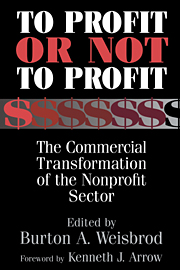Book contents
- Frontmatter
- Contents
- List of contributors
- Foreword by Kenneth J. Arrow
- Preface
- 1 The nonprofit mission and its financing: Growing links between nonprofits and the rest of the economy
- Part I Basic issues and perspective
- Part II Industry studies
- 8 Commercialism in nonprofit hospitals
- 9 Universities as creators and retailers of intellectual property: Life-sciences research and commercial development
- 10 Commercialism in nonprofit social service associations: Its character, significance, and rationale
- 11 Zoos and aquariums
- 12 Commerce and the muse: Are art museums becoming commercial?
- 13 The funding perils of the Corporation for Public Broadcasting
- Part III Overview, conclusions, and public-policy issues
- Appendix: IRS Forms 990 and 990-T for nonprofit organizations
- References
- Index
11 - Zoos and aquariums
Published online by Cambridge University Press: 30 November 2009
- Frontmatter
- Contents
- List of contributors
- Foreword by Kenneth J. Arrow
- Preface
- 1 The nonprofit mission and its financing: Growing links between nonprofits and the rest of the economy
- Part I Basic issues and perspective
- Part II Industry studies
- 8 Commercialism in nonprofit hospitals
- 9 Universities as creators and retailers of intellectual property: Life-sciences research and commercial development
- 10 Commercialism in nonprofit social service associations: Its character, significance, and rationale
- 11 Zoos and aquariums
- 12 Commerce and the muse: Are art museums becoming commercial?
- 13 The funding perils of the Corporation for Public Broadcasting
- Part III Overview, conclusions, and public-policy issues
- Appendix: IRS Forms 990 and 990-T for nonprofit organizations
- References
- Index
Summary
Introduction
Those who have not visited a zoo or aquarium since LBJ was president will find a quite different place. The menagerie mentality, cages and tanks arranged for display purposes, has disappeared. The best zoos are no longer those with the most different kinds of animals. As part of the ecological awakening that culminated in the passage of the Endangered Species Act of 1973, and part of their historic mission of exhibiting animals, zoos and aquariums transformed their display space from cages and tanks to habitats designed to promote normal behavior. By helping to create an environment in which breeding could take place, this investment in new capital helped promote a second mission, one to which these institutions have rededicated themselves – species preservation.
There have been other changes as well: To facilitate research, laboratories and libraries have been expanded. To provide education, classrooms have been constructed and teachers hired. All the while, zoos and aquariums have tried to remain financially accessible to low-income citizens. What has changed little since the founding of the American Zoo and Aquarium Association (AZA) in the 1920s is the mission of these institutions:
to promote and advance zoological parks and aquariums; to aid in the exchange and importation of zoological specimens; to provide exhibits for scientific, educational and recreational purposes; and to aid in the preservation of wild life.
- Type
- Chapter
- Information
- To Profit or Not to ProfitThe Commercial Transformation of the Nonprofit Sector, pp. 217 - 232Publisher: Cambridge University PressPrint publication year: 1998
- 2
- Cited by



